Do you have a first aid kit ready at home?
Do you have one when you are off hiking, away from the proximity of EMS responders?
How about in your vehicle?
Today we will be looking at the essentials necessary to maintain a first aid kit (FAK), and some advice on administering first aid. Off the shelf, a FAK contains basic staples that should be included in all first aid kits. However, it’s essential to understand that different circumstances require different FAK items. Just as you would pack different clothes for an outdoor hiking trip as opposed to a business conference, your first aid kits need to be tailored for a multitude of occasions, and available for quick retrieval from multiple locations.
We will list the essentials which should be in every single first aid kit, and continue with the necessary items for keeping in your home, an outdoor activity away from a quick response from EFR units, and your car. Finally, we will describe how to check, maintain, and stock your first aid kit.
The Bare Necessities – The Essential First Aid Kit
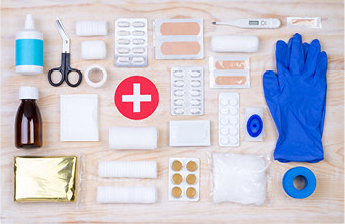
· Durable container – a first aid bag or empty metal first aid box to keep all of your items in.
· Phone numbers - for emergency services, emergency contact information.
· Prescription medication, with dosage instructions – if your family member or partner has a condition that requires prescription medication, keep it handy in the FAK.
· Medical Exam Gloves – these are necessary to act as a barrier against blood-borne pathogens (make sure to include spares in case they tear or get punctured).
· Sterile gauze pads - for cuts and grazes, multiple sizes, which can be used in tandem with.
· Adhesive tape - for dressing wounds and fixing the gauze in place.
· Sterile cotton - to dress wounds directly.
· Clinging rolled bandages - to bandage dressed wounds (in various sizes).
· Cotton-tipped swabs - to clean wounds.
· Scissors - to cut clothes or dressings.
· Tweezers or needles - for removing foreign matter.
· Triangular bandage – to wrap up and immobilize dislocations, sprains, and fractures.
· Oral thermometer – to check body temperature in case of fever, hypothermia.
· Ventilation barriers such as a CPR pocket mask or face shield - for dealing with emergency resuscitation.
· Antibacterial hand wash or soap - to clean yourself up after administering care.
Being Ready at Home – The Multipurpose First Aid Kit
Above we listed items any first aid kit should have. With that in mind, let’s assemble one that you can confidently keep at home for a diverse range of first aid assistance to your entire family. Think about this as your “multipurpose first aid kit.” It should contain all the items from the list.
The primary use of this first aid kit is to treat your family members, so it should be personalized to your families’ needs. Take into account any individual needs which need to be catered for - if you have young children at home, you may want to include Paracetamol suitable for kids or sun lotion for their sensitive skin. For elderly family members, you might want to add medication dosage and schedule for each medicine.
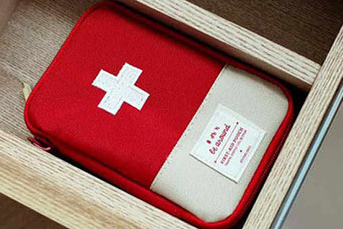
At home, you’ll also be dealing with illnesses, and ongoing care, as well as emergencies and injuries so you should include:
· Contact details for your local hospital practitioner, and family doctor.
· Lists of allergies, pre-existing medical conditions, and prescribed medication for each family member.
· Antibiotic ointment to prevent wound infection.
· Aspirin and non-aspirin (depending on your pre-existing medical conditions) pain relievers.
· Paracetamol for relieving fevers.
· Activated charcoal for food poisoning or stomach upsets.
· A paper cup to cover or bathe eye injuries.
· Diarrhea medication.
· Anti-nausea & vomiting medication for upset stomachs.
Venturing out into nature - First Aid Kit for Outdoors
Outdoor activities are an excellent way to keep fit, stay healthy and enjoy nature. To make sure you are prepared for a hiking adventure, build your outdoor and hiking kit by starting with the essentials listed above. Ensure you have the basics. Next, add multiple items that will provide prevention and treatment of the most common injuries that can occur while hiking - dehydration, blisters, sprains, insect stings, cuts and abrasions, and exposure. These are the most common causes of problems in the wild and can lead to more extreme consequences when you are away from civilization.
An added note of warning - always bring a means of communication with you, and inform yourself of any dangerous animals, insects or extreme weather conditions in the area before you head out.
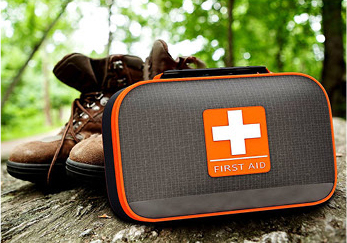
To prepare for possible outdoor incidents, add the following first aid kit items to your Essential FAK:
· A list of participants of the trip. Each hiker should include their phone numbers in case you lose track of them, and details of any allergies and prescription medications they may be taking.
· A cell phone - to be able to contact EFR in case of a need for extraction. Ensure your cell has credit, and a full battery when leaving home.
· Large absorbent dressings - to use as pressure pads in case of more severe cuts and bleeding occurs.
· Adhesive bandages - to hold dressings in place, or to secure a make-shift splint if you do not have a medical one.
· Safety pins - To be used to secure bandages in place in the event of sprains.
· Medical splints - to immobilize sprains. You really should have these in case the only possible way to receive professional help is a long walk back.
· Squeeze bottle of water -to be used for hydration, or to wash out wounds in a spurt of pressurized water.
· Hot packs – to denature venomous bites or stings. Heating all venoms led to the denaturation and loss of some harmful proteins in the venom.
· Hydrocortisone ointment – to be used for stings or skin irritations.
· Antihistamines - for hay fever and for other allergic reactions.
· Rehydration drink sachets – to be dissolved in water to quicken the body response for a faster, more effective rehydration.
· Plastic bags – to dispose of used items and medical waste. Plastic bags can also be used for keeping a bandaged foot or ankle dry.
· Antibacterial soap - to wash wounds with.
· Antiseptic solution - to clean wounds after washing.
· Sugar packets, candy, granola bars, nuts – to access to a dense high-calorie food source, when your blood sugar drops. Having some is crucial if you get stranded in an isolated area for an extended period.
· Emergency Mylar Blankets - to be used for warmth and shelter if unexpectedly stranded and need to wait for help to reach you. Mylar blankets can also be used to treat shock and hypothermia.
· Penlight - to be used as an examination tool and an emergency light if stranded overnight.
On the Road - First Aid Kit for Your Vehicle
By now you realize that having a well-stocked and ready-to-use first aid kit is one of the best ways you can prepare for emergencies. Having one in your vehicle when you’re not in the safety of your home is an extra layer of protection. You may be at the gym when you suffer a mild sports injury; you may be in a car accident, or you may need to spend the night in your truck during a snowstorm. For any of these, you will do well to equip your vehicle with a FAK.
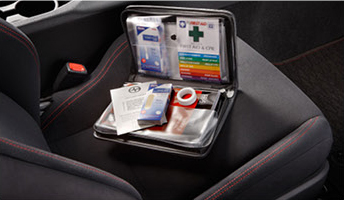
As always, when tailoring the first aid kit for your vehicle, start with the Essential FAK. It will give you a substantial base from which to add more driving-specific items. The most extreme scenario which can occur on the roads is a severe road traffic accident involving multiple vehicles. In such instances, always ensure you have your phone with you and although not a first aid kit item, prepare a warning reflecting triangle which can be placed on the road to warn other vehicles of a hazard ahead. The first aid kit for your car should include:
· Adhesive bandages in various sizes - to dress wounds.
· Non-adherent, dry pads - to dress burns.
· A variety of medical splits - to immobilize sprained or fractured limbs, which are an unfortunate result of most car accidents.
· Foam neck collar - to immobilize the neck and prevent further spinal injuries to victims of accidents on the road.
· A range of pads – to apply pressure to wounds with severe bleeding.
· Automatic External Defibrillator (AED): If available, for unresponsive victims.
Stay Safe - Maintaining Your First Aid Kits
We have guided you on how to prepare for emergencies and incidents in your home, outdoors and on the road. These are not all the situations where you might need a FAK, but they are common for most people in today's everyday life.
However, just having a kit is not enough. You must make sure the items it carries are up to date, in good condition and ready for use in an emergency. Here is advice on how to store it, stock and re-stock it.
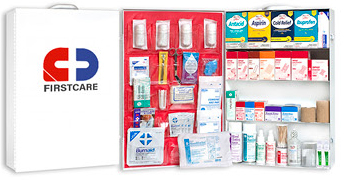
Storage:
· Make sure your first aid kit is an easily accessible place. If you have young children, keep it accessible, but out of their reach. A wall-mountable first aid cabinet would be ideal.
· Guarantee everyone in your home, trip, or in the car knows where to locate it.
· Store it in a dry area, and out of direct sunlight.
Medication:
· Always check that all medication is clearly marked and is safe to still use by the stated date on the packaging.
· Keep any directions for dosage and usage with the medication. Keep a pen here so you can make a note of the amount given when you administer it, and symptoms noticed.
Re-Stocking:
· Keep a “shopping list” of all items contained in the FAK.
· Mark off whenever you use the FAK items. Restock items regularly, before they become depleted.
Be Ready – Practice Using Your Well-stocked First Aid Kit
You have equipped yourself, stocked up, and made sure you have prepared for most eventualities. To put it all together, you are left with the most crucial process – training. Ensure you are ready to help the ones you care about the most in time of need by practicing the proper first aid care in a low-stress environment. In a moment of need, the stress might be too high for you to remember to properly take care of your loved ones - this is why you have to practice regularly. Take the time to practice first aid kit use with your family. Explore your first aid kit and identify the items you can use; turn it into a game to play with your kids. Children are fast learners; they can take care of themselves or you in a crisis. Do not underestimate the empowerment of knowing how to take care of an injury from an early age.
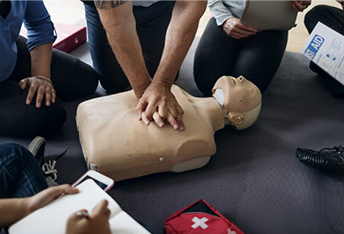
If you have a chance to, learn about Emergency First Response Courses you can take in your area. Taking a course taught by professionals in the field can be a powerful way to feel more confident about helping your family and friends. If you have a certificate already, congratulations – you are a responsible member of your community and will be a great asset to your closest ones, and your neighborhood during troubled times. If you don’t feel confident in your certified skills, take a refresher course. A refresher course will bring your skills up to date, and you’ll be able to practice more advanced skills, like giving CPR on a manikin using a pocket mask or even ambu bag valve mask. Email us at info@firstcaresolutions.com for our latest catalogue and free quote of first aid kit!





















 2755841275@qq.com
2755841275@qq.com 13159238790
13159238790